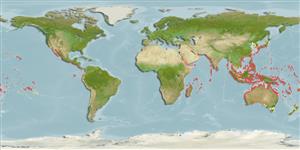Common names from other countries
Classification / Names / Names
Nombres comunes | Sinónimos | Catalog of Fishes (gen., sp.) | ITIS | CoL | WoRMS
Environment: milieu / climate zone / depth range / distribution range
Ecología
. Tropical
Distribución
Países | Áreas FAO | Ecosistemas | Ocurrencias, apariciones | Introducciones
Indian Ocean: from Egypt to Mozambique, including the Red Sea, Seychelles, Madagascar, Mauritius, Réunion, Rodrigues and Mascarene Islands, east to India and south to Dampier, Western Australia, including Andaman Sea, Laccadive Islands, Maldives, Sri Lanka and Nicobar Islands; Pacific Ocean: from China to the south China Sea, south to New Zealand, including Federated States of Micronesia, Fiji, Norfolk Islands, the Great Barrier Reef, Lord Howe Island, Tasmania and French Polynesia, east to Chile, including Samoan Archipelago and Hawaiian Islands.
Length at first maturity / Tamaño / Peso / Age
Maturity: Lm ? range ? - ? cm
Thallus forming a dark green, amorphous to convoluted spongy mass, composed of central medulla and cortex. Medulla consisting of branched cylindrical filaments, their tips inflated into cylindrical to clavate utricles forming the cortex.Hairs or hair scars occur in 1 to 3 vertical rows, at some distance from the tip of the utricle. Gametangia cylindrical and tapering towards both ends, borne at the side of the proximal portion of the utricle. Amorphous clumps up to 5 cm in diameter (Ref. 80758).
Used for human consumption and as medicine (Ref. 80758).
Guiry, M.D. and G.M. Guiry. 2009. (Ref. 80701)
IUCN Red List Status (Ref. 130435: Version 2024-1)
CITES status (Ref. 108899)
Not Evaluated
Not Evaluated
Threat to humans
Human uses
Pesquerías: comercial
| FishSource |
Herramientas
Más información
Age/SizeCrecimientoLength-weightLength-lengthMorfologíaLarvaAbundancia
Fuentes de Internet
Estimates based on models
Preferred temperature
(Ref.
115969): 24.6 - 29.3, mean 28.4 (based on 2952 cells).
